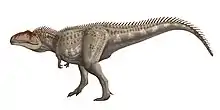Candeleros Formation
The Candeleros Formation (formerly known as the Candeleros Member of the "Río Limay Formation") is a geologic formation that crops out in the Río Negro, Neuquén, and Mendoza provinces of northern Patagonia, Argentina. It is the oldest formation in the Neuquén Group and belongs to the Rio Limay Subgroup. Formerly that subgroup was treated as a formation, and the Candeleros Formation was known as the Candeleros Member.[1]
| Candeleros Formation Stratigraphic range: early Cenomanian-early Turonian ~99–92 Ma | |
|---|---|
 Candeleros Formation near Cerro El Vagon, Neuquen, Argentina | |
| Type | Geological formation |
| Unit of | Neuquén Group Río Limay Subgroup |
| Underlies | Huincul Formation |
| Overlies | Lohan Cura Formation |
| Thickness | 300 m (980 ft) |
| Lithology | |
| Primary | Eolian sandstone |
| Other | Conglomerate, siltstone, paleosol |
| Location | |
| Coordinates | 39.4°S 69.2°W |
| Approximate paleocoordinates | 46.5°S 45.5°W |
| Region | Mendoza, Neuquén & Río Negro Provinces |
| Country | |
| Extent | Neuquén Basin |
| Type section | |
| Named for | Candeleros Hill |
| Named by | Wichmann |
| Year defined | 1929 |
 Candeleros Formation (Argentina) | |
Description
The type locality of the Candeleros Formation is Candeleros Hill in Neuquén Province, after which the formation was named by Wichmann in 1929.[2] This formation unconformably overlies the Lohan Cura Formation, and it is in turn overlain by the Huincul Formation, also a unit of the Neuquén Group. The sediments of the latter are of lighter greenish and yellow colors and the boundary between the Candeleros and Huincul formations is easily recognizable.[3]
The Candeleros Formation is almost 300 metres (980 ft) thick in some sections. Overall, the formation represents an ancient braided river system, made up mostly of sandstones and conglomerates. There are also isolated sections that represent eolian (wind-blown) deposition, as well as siltstones deposited under swamp conditions. Paleosols (soil deposits) are common in some sections as well.[1][3]
Fossil content


The Candeleros Formation has a very diverse fossil fauna, including:
- dipnoan fish (including Ceratodus argentinus)
- frogs
- Iguanodonts
- eilenodontine rhynchocephalians (including Priosphenodon avelasi)
- primitive snakes (including Najash rionegrina)
- several turtles (including 2 species of Prochelidella)
- rebbachisaurid sauropods (Limaysaurus, Nopcsaspondylus and Rayososaurus)
- titanosaurian sauropods (including Andesaurus and a second unnamed huge titanosaur )
- abelisaurid theropods (Ekrixinatosaurus and unnamed form[4])
- a carcharodontosaurid theropod (Giganotosaurus)
- a dromaeosaurid theropod (Buitreraptor gonzalezorum)
- an alvarezsaurid theropod (Alnashetri)
- a basal coelurosaurian (Bicentenaria)
- cladotherian mammals (including Cronopio dentiacutus)
- ichnofossils of Sousaichnum monettae, Limayichnus major, Bonaparteichnum tali, Bressaniichnus patagonicus, Deferraiichnum mapuchense, Abelichnus astigarragae and Picunichnus benedettoi[5]
In 2021, fossil material of a giant titanosaur sauropod, distinct from Andesaurus and probably exceeding Patagotitan in size, was described from the formation by Otero et al. (2021).[6]
See also
- List of fossil sites
- Bajo Barreal Formation, contemporaneous fossiliferous formation of the San Jorge Basin
- Cerro Fortaleza Formation, contemporaneous fossiliferous formation of the Austral Basin
- Alcântara Formation, contemporaneous fossiliferous formation of the São Luís-Grajaú Basin, Brazil
- List of dinosaur bearing rock formations
References
| Wikimedia Commons has media related to Candeleros Formation. |
- Sánchez et al., 2006
- Wichmann, 1929
- Leanza et al., 2004
- Canale et al., 2016
- Leonardi, 1994, p.79
- Otero et al., 2021
Bibliography
- Otero, A.; J. L. Carballido; L. Salgado; J. I. Canudo, and A. C. Garrido. 2021. Report of a giant titanosaur sauropod from the Upper Cretaceous of Neuquén Province, Argentina. Cretaceous Research in press. Article 104754. doi:10.1016/j.cretres.2021.104754
- Canale, Juan I.; Ignacio Cerda; Fernando E. Novas, and Alejandro Haluza. 2016. Small-sized abelisaurid (Theropoda: Ceratosauria) remains from the Upper Cretaceous of northwest Patagonia, Argentina. Cretaceous Research 62. 18–28. doi:10.1016/j.cretres.2016.02.001
- Sánchez, María Lidia; Susana Heredia, and Jorge O. Calvo. 2006. Paleoambientes sedimentarios del Cretácico Superior de la Formación Plottier (Grupo Neuquén), Departamento Confluencia, Neuquén (Sedimentary paleoenvironments in the Upper Cretaceous Plottier Formation (Neuquen Group), Confluencia, Neuquén). Revista de la Asociación Geológica Argentina 61. 3–18. Accessed 2019-02-16.
- Leanza, H.A.; S. Apesteguia; F.E. Novas, and M.S. De la Fuente. 2004. Cretaceous terrestrial beds from the Neuquén Basin (Argentina) and their tetrapod assemblages. Cretaceous Research 25. 61–87. Accessed 2019-02-16.
- Leonardi, Giuseppe. 1994. Annotated Atlas of South America Tetrapod Footprints (Devonian to Holocene) with an appendix on Mexico and Central America, 1–248. Ministerio de Minas e Energia - Companhia de Pesquisa de Recursos Minerais, Geological Service of Brazil. Accessed 2019-03-25.
- Wichmann, R. 1929. Los Estratos con Dinosaurios y su techo en el este del Territorio del Neuquén ("The dinosaur-bearing strata and their upper limit in eastern Neuquén Territory"). Dirección General de Geología, Minería e Hidrogeología Publicación 32. 1–9.
